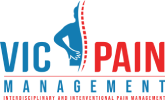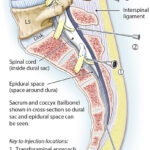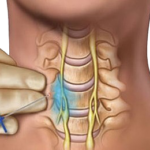If you have a good response to facet joint injections in the lower back or in the neck, then it may be possible to make the treatment more effective by doing facet joint denervation. If your pain has returned, then denervation can turn off the nerves that run from the painful joints and produce long-lasting pain relief. If the muscles or nerves are contributing to your pain, then the benefit will not be as great.
Each facet joint is supplied by two to four small nerves. The aim of treatment is to identify each branch by gentle electrical stimulation, and then to heat each branch very precisely, causing the nerve to die back. Each joint will need between two and four injections. We can realistically treat up to three joints lying next to one another, or one joint on either side. This will take about an hour.
The sacroiliac joints can be treated in the same way, but a single sacroiliac joint will need between four and six injections, and also take an hour to treat.
Denervation can be uncomfortable: you Will need to lie on your stomach for up to an hour. Cold chlorhexidine or iodine is used to clean the skin. Local anaesthetics (lignocaine, bupivacaine or I-bupivacaine) and anti-inflammatory steroids (methylprednisolone or triamcinolone) are injected. A small needle or cannula will be inserted into a vein in case the treatment causes an allergic reaction or fainting. There may be temporary numbness or weakness of the arm if the neck is treated, or of the leg if the back is treated. After 12-24 hours there may be an increase in pain lasting from a few days to a few weeks. Despite a good response to facet joint injections, the response to denervation is sometimes disappointing.
We cannot perform denervation if you are taking warfarin, have taken aspirin within 12 days or have infection at the site of the treatment. X-rays are used to guide the treatment: if you are pregnant we cannot proceed.
The treatment begins with the insertion of a cannula into your hand or arm. You will then be helped to lie on your stomach, and the skin over the joints will be cleaned with cold antiseptic. An X-ray of the joints will be taken, and local anaesthetic injected into the skin above the joints: after a brief stinging sensation, the skin will go numb. The X-ray machine is used to guide a treatment needle onto the first nenze, which is sometimes uncomfortable. A tiny electrical current is passed into the needle, and will be asked if there is any change in the sensation from the joint, the back or the neck. You may feel aching, pain, tingling or an “electrical” sensation. This is called “stimulation”, and may need to repeated one or more times. It helps us to position the needle very close to the nerve.
When the needle is properly positioned we will repeat the stimulation, but the sensation may be different, with a feeling ofjumping, tapping or twitching in the muscles. If this feeling spreads to the arm or the leg, then the needle is in the wrong position, and will be moved to a new place.
Once the needle is in a good position, we inject a small amount of local anaesthetic to numb the nerve, wait for a minute or two, and then heat the needle to about the temperature of a cup of tea for one to two minutes. A tiny area of the nerve will be damaged. If this heating is painful, the treatment will be halted, and more local anaesthetic given (there is usually no pain at all). Finally, a small injection of steroid will be given onto the joint.
This sequence will be repeated for each branch ofthe nerve that is to be treated.
At the end of the treatment, you will return to the recovery ward, be monitored for a while, then have something to eat or drink. You should then be able to go home, although if your leg is a little numb or weak we may need to keep you on the ward until it begins to recover.
We wilt arrange to see you in the clinic in 6-10 weeks. If several joints need treatment, we may have to treat some joints and repeat the treatment on the other joints after a month or so.



